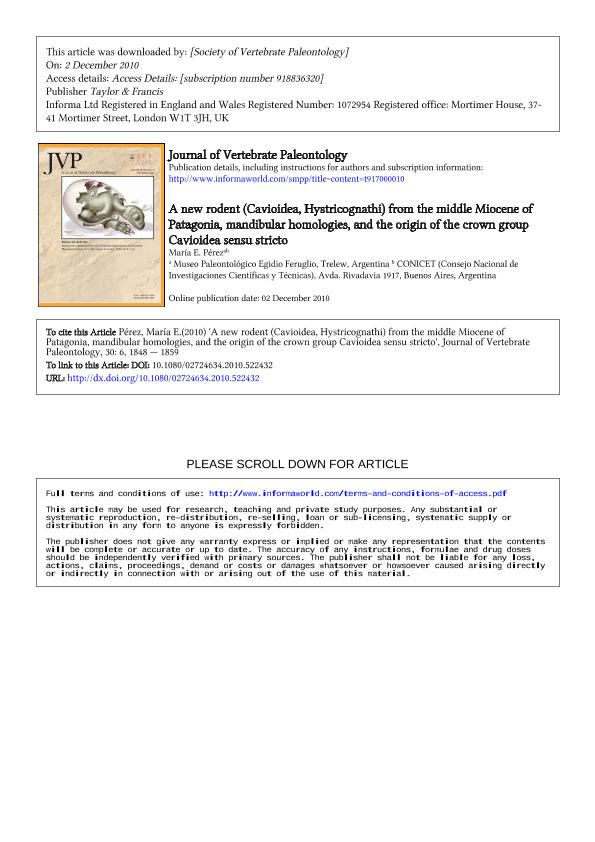Artículo
A new rodent (Cavioidea, Hystricognathi) from the middle Miocene of Patagonia, mandibular homologies, and the origin of the crown group Cavioidea sensu stricto
Fecha de publicación:
11/2010
Editorial:
Society of Vertebrate Paleontology
Revista:
Journal of Vertebrate Paleontology
ISSN:
0272-4634
Idioma:
Inglés
Tipo de recurso:
Artículo publicado
Clasificación temática:
Resumen
Cavioidea sensu stricto groups three traditionally recognized families that are characterized by hypsodont, double-heart-shaped cheek teeth and moderate hystricognathy: Eocardiidae, Caviidae, and Hydrochoeridae. Eocardiidae was erected to include a diverse assemblage of extinct and plesiomorphic taxa, whereas Caviidae and Hydrochoeridae (the crown group of Cavioidea) include the lineages with extant representatives (cuyes, maras, and capybaras). A new genus and species of Cavioidea sensu stricto, Guiomys unica, is described here from the middle Miocene of west central Patagonia (Argentina). The new taxon is known from mandibular and maxillary fragments with molars, and isolated cheek teeth. A phylogenetic analysis of Cavioidea sensu stricto shows G. unica as the sister taxon of the clade formed by the crown group of Cavioidea sensu stricto ('medialis series'). The new species displays characters states intermediate between eocardiids and the 'medialis series.' The most outstanding character of Guiomys unica is the autapomorphic position of the notch for the insertion of the masseter medialis pars infraorbitalis muscle, isolated from both the masseteric and horizontal crests. This notch is located at the anterior end of the masseteric crest in eocardiids and represents the plesiomorphic state for Cavioidea sensu stricto. In caviids and hydrochoerids, the notch is located at the anterior end of the horizontal crest, the derived state for this character. G. unica allows reinterpretation of the homologies of the mandibular crests in basal cavioids and clarifies the evolutionary origins of crown-group cavioids (Caviidae + Hydrochoeridae).
Palabras clave:
Cavioidea
,
Miocene
,
South America
,
Patagonia
Archivos asociados
Licencia
Identificadores
Colecciones
Articulos(SEDE CENTRAL)
Articulos de SEDE CENTRAL
Articulos de SEDE CENTRAL
Citación
Pérez, María Encarnación; A new rodent (Cavioidea, Hystricognathi) from the middle Miocene of Patagonia, mandibular homologies, and the origin of the crown group Cavioidea sensu stricto; Society of Vertebrate Paleontology; Journal of Vertebrate Paleontology; 30; 6; 11-2010; 1848-1859
Compartir
Altmétricas




